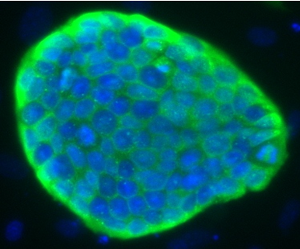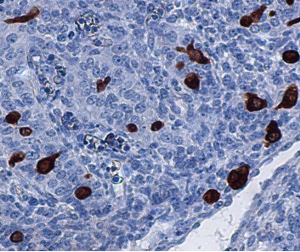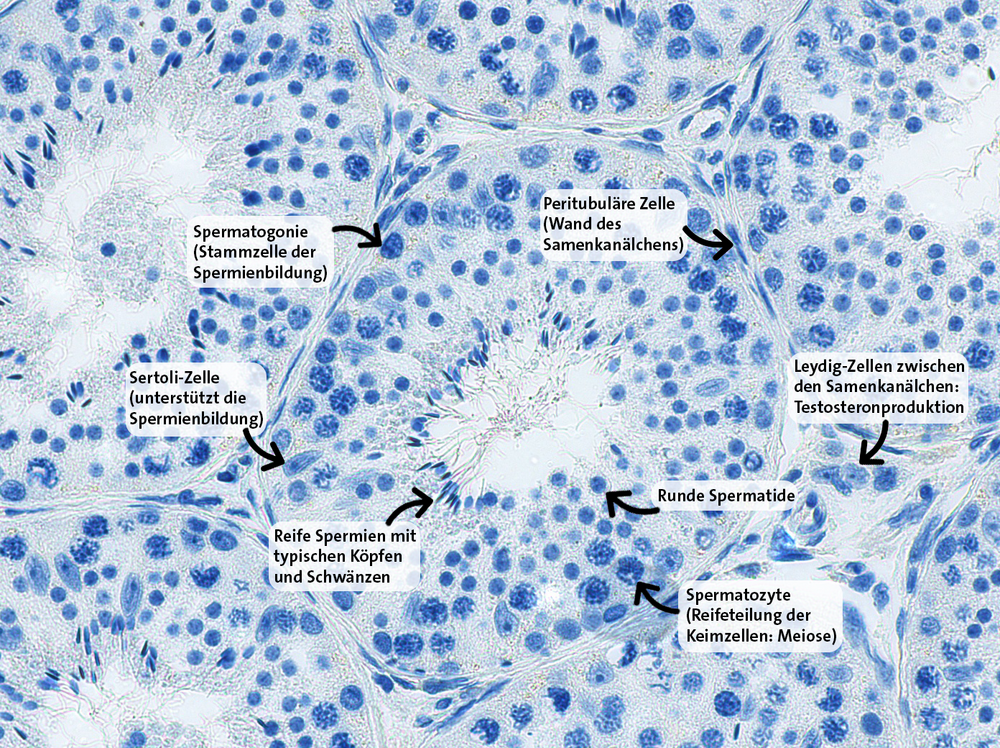Germ cells
Germ cells are essential for reproduction and evolution of all sexually reproducing organisms. Most of our knowledge about the characteristics and properties of mammalian germ cells was obtained from the mouse as model organism. However, there are significant differences between mouse and primate germ cells. We are especially interested in primate germ cells and investigate their development and characteristics in situ (in the context of the whole organ) as well as in vitro (i.e. in cell culture).


The mammalian testis produces several millions of sperm cells per day. Besides the bone marrow it is the tissue exhibiting the highest cell proliferative activity. Testicular stem cells, which fuel this huge amount of sperm output, are called spermatogonial stem cells. Like other adult stem cell types, they are on the one hand able to maintain their own stem cell pool and, on the other hand, to replenish the pool of sperm cell progenitors, which subsequently differentiate into sperm cells. Interestingly, spermatogonial stem cells as well as their developmental progenitors (primordial germ cells and gonocytes) share many characteristics with pluripotent embryonic stem cells. We are investigating molecular and cellular similarities between pluripotent stem cells and premeiotic germ cells in primates.

The testis has several crucial functions. Firstly, it produces the male sex hormone testosterone, which is necessary for the function of the testis itself, but also for other reproductive organs, the prevention of osteoporosis (softening of the bones) and the normal functioning of other organs. Secondly, the testis is essential for the evolution of mammalian species, including humans. The testis continuously produces mature reproductive cells - sperm - from stem cells via various intermediate stages. In a healthy man, about 1,000 sperm are produced every second - practically for a lifetime.
The organ of mammalian evolution
As such, the testis is a " machinery " for the production of sperm, trimmed for the highest efficiency and at the same time the highest endurance. The production of sperm from stem cells is called spermatogenesis. Interestingly, despite its fundamental and essential function for the survival of all mammalian species, the testis exhibits an extremely high evolutionary tempo compared to other organs: the molecular, cellular and tissue fine structure of the testis and spermatogenesis itself develop rapidly in mammals. One reason for this is probably the evolutionary pressure on males to successfully reproduce in competition with rivals.
However, it is not only important that many sperm are produced, but also that each sperm, after undergoing a cell division that is typical of germ cells, meiosis, has an individual combination of the genetic make-up of the parents of the person in whose testis the sperm are produced. If a sperm then fertilises an egg cell, which also has a unique new combination of hereditary dispositions, a new individual is generated with its own unique combination of hereditary dispositions, which controls the development of all organs of the human or animal. This mechanism alone, however, would only allow for a mixing of the already existing genetic information at a pre-existing level. Evolution, however, is constantly testing something completely new.
Playground for changes in genetic information
The testis is largely responsible for this. It repeatedly produces new genes in individual germ cells, transforms the existing genetic material and plays with the genetic information, so to speak. This new genetic information can then, if it has a beneficial effect in the conceived individual of the next generation, produce a completely new quality in the individual. Our large human brain, our upright gait, our good fine motor skills of the fingers, parts of our behaviour and much more have come into being through the recombination as well as new emergence of hereditary information in germ cells.
For the evolution of a mammal, therefore, only the changes in the genetic material in germ cells are important - those in the somatic cells, on the other hand, are not. In addition to this fundamental evolutionary function of germ cells at the organismic and species level, germ cells themselves are also subject to evolutionary pressure. Sperm cells have adapted depending on the mating system, for instance firm lifelong partnerships or loose groups with many competing mating partners. Among other things, the size, shape, speed and lifespan of the sperm can be optimised to successfully fertilise an egg. The genetic information of the sperm is thus not only subject to selective pressure at the level of the organism as a whole, but also with regard to the fitness of the sperm themselves.
The molecular evolution of spermatogenesis across mammals.
Nature, https://www.nature.com/articles/s41586-022-05547-7
Aeckerle N, Eildermann K, Drummer C, Ehmcke J, Schweyer S, Lerchl A, Bergmann M, Kliesch S, Gromoll J, Schlatt S, Behr R (2012):
The pluripotency factor LIN28 in monkey and human testis: a marker for spermatogonial stem cells?
Mol Human Reprod 18(10): 477-488.
Warthemann R, Eildermann K, Debowski K, Behr R (2012):
False-positive antibody signals for the pluripotency factor OCT4A (POU5F1) in testis-derived cells may lead to erroneous data and misinterpretations.
Mol Hum Reprod 18(12): 605-612.
Eildermann K, Aeckerle N, Debowski K, Godmann M, Christiansen H, Heistermann M, Schweyer S, Bergmann M, Kliesch S, Gromoll J, Ehmcke J, Schlatt S, Behr R (2012):
Developmental expression of the pluripotency factor SAL-Like Protein 4 in the monkey, human and mouse testis: restriction to premeiotic germ cells.
Cells Tissues Organs 196 (3): 206-220.
Eildermann K, Gromoll J, Behr R (2012):
Misleading and reliable markers to differentiate between primate testis-derived multipotent stromal cells and spermatogonia in culture.
Hum Reprod 27: 1754-1767.
